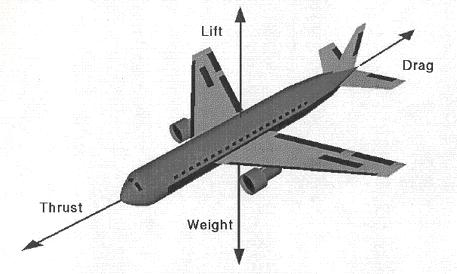
Have you ever wondered how those magnificent machines, the airplanes, defy gravity and soar through the skies? The answer lies in the principle of flight which is a complex and dynamic phenomenon governed by the interplay of various physical forces. There are four fundamental forces that govern how an aircraft flies and its state of flight at any one time. These four forces are LIFT, WEIGHT, THRUST & DRAG as shown in Figure 1 below.

Figure 1: The Four Forces of Flight: Lift, Weight, Thrust and Drag
Here, in this article, we will simplify the fundamental forces for you to have a clear understanding.
Lift
Lift is the upward force that counteracts the downward force of gravity, allowing an aircraft to stay airborne. It is generated by the movement of air over the wings. As air flows over the curved upper surface of the wing, it speeds up, creating a pressure difference between the upper and lower surfaces. This pressure difference results in an upward force, which is known as lift. The amount of lift generated depends on the shape and size of the wing, as well as the airspeed of the aircraft.
Weight
Weight, the downward force of gravity acting on the aircraft's mass, is the force that lift must counteract. The weight of an aircraft is determined by its mass, which includes the structure, engines, payload, fuel, and any other items carried on board. As fuel is consumed during flight, the weight of the aircraft decreases, while the weight increases as cargo or passengers are added.
Thrust
Thrust, the force that propels the aircraft forward through the air, is generated by the aircraft's engines. Jet engines, propellers, and rockets are common types of aircraft engines that produce thrust. Thrust is necessary to overcome the drag force, which opposes the aircraft's forward motion. The amount of thrust required depends on the aircraft's weight, desired speed, and air density.
Drag
Drag, the force that resists the aircraft's motion through the air, is caused by friction between the aircraft's surfaces and the air molecules. Drag is proportional to the square of the aircraft's speed, meaning that as the aircraft speeds up, drag increases exponentially. This is why aircraft engines must produce more thrust to maintain a higher speed.
Understanding the interplay of lift, weight, thrust, and drag provides a foundational grasp of flight dynamics. Whether pursuing an aviation career or driven by a personal interest, this knowledge forms the basis for further exploration. For those considering a future in aviation, the GMR Aero Academy (GMRAA) offers comprehensive programs in the aviation industry.